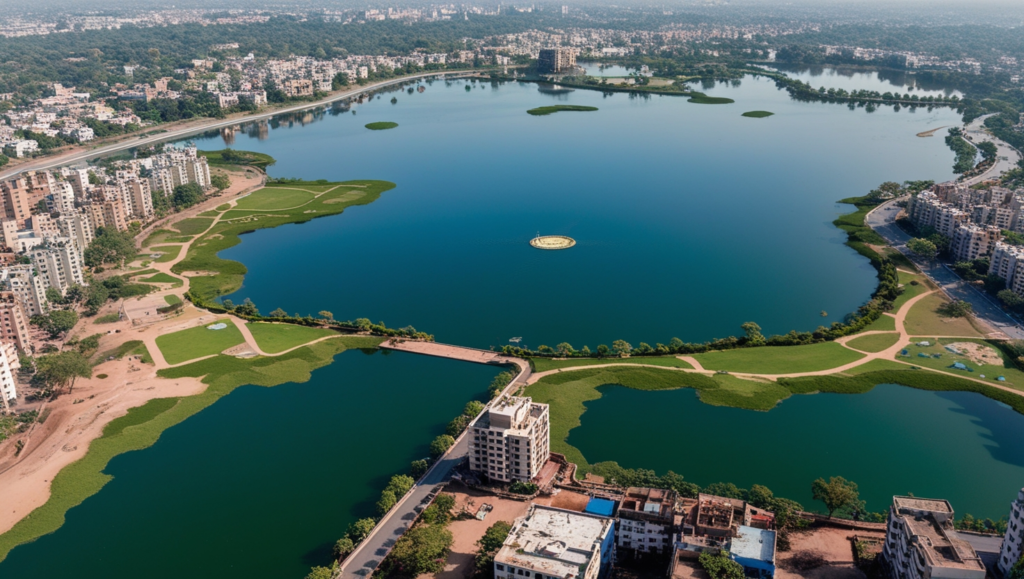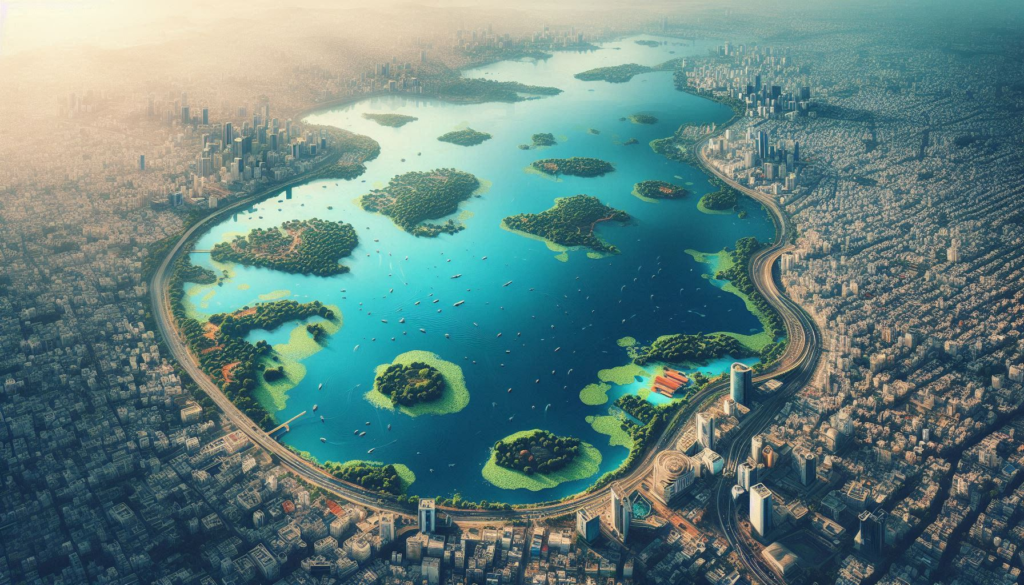Hyderabad, known for its rich history and technological prowess, is also home to a vast network of lakes that play a crucial role in the city’s ecosystem. The Hyderabad Metropolitan Development Authority (HMDA) has been entrusted with the responsibility of managing and preserving these vital water bodies.
In this comprehensive guide, we’ll delve deep into the HMDA lakes in Hyderabad, exploring their distribution, characteristics, and the measures taken to protect them.
Table of Contents
Understanding the Scope of HMDA Lakes
The HMDA has meticulously documented 2,570 lakes within its jurisdiction, spanning across various districts including Rangareddy, Medchal-Malkajgiri, Sangareddy, Siddipet, and Yadadri-Bhongiri. This extensive network of water bodies forms the backbone of Hyderabad’s urban ecology.
Distribution of HMDA Lakes
The lakes under HMDA’s purview are spread across different districts:
- Rangareddy District: Home to a significant number of lakes, including those in areas like Shamshabad, Maheswaram, and Ibrahimpatnam.
- Medchal-Malkajgiri District: Features lakes in areas such as Keesara, Ghatkesar, and Shamirpet.
- Sangareddy District: Contains lakes in regions like Patancheru, Ameenpur, and Ramachandrapuram.
- Siddipet District: Houses lakes in areas like Mulugu and Wargal.
- Yadadri-Bhongiri District: Includes lakes in Bhongir and Choutuppal areas.
HMDA Lakes Map Hyderabad: A Geographical Perspective
The HMDA lakes map Hyderabad provides a crucial visual representation of the distribution of these water bodies across the metropolitan area. While we don’t have access to the actual map in this context, we can infer its importance based on the data provided.

Key Insights from the HMDA Lakes Data
- Diverse Sizes: The lakes range from small ponds to large reservoirs. For instance, the Osmansagar Reservoir (ID: 2907) in Gandipet is one of the larger water bodies.
- Urban Integration: Many lakes are situated within or close to urban areas, highlighting the need for careful urban planning. Examples include lakes in Kukatpally (IDs: 4801-4811) and Malkajgiri (IDs: 4700-4702).
- Historical Significance: Some lakes, like the Mir Alam Tank (ID: 4400) in Bahadurpura, have historical importance dating back to the Nizam era.
- Interconnected Systems: The data suggests that many lakes are part of interconnected systems, especially in areas like Shamirpet and Keesara.
HMDA Lakes FTL Maps PDF Download: Understanding Lake Boundaries
The Full Tank Level (FTL) maps are crucial documents for lake management. While we don’t have direct access to these PDFs, the data provided gives us insights into why these maps are essential.
Importance of FTL Maps
- Boundary Demarcation: FTL maps help in clearly defining the maximum extent of each lake. This is crucial for preventing encroachments and planning buffer zones.
- Flood Management: Understanding the FTL helps in predicting and managing potential flooding scenarios, especially for lakes like Hussain Sagar (ID: 3900) which is surrounded by densely populated areas.
- Conservation Planning: FTL information is vital for restoration efforts. For instance, the Pedda Cheruvu in Bhongir (IDs: 3345-3347) would require accurate FTL data for any conservation initiatives.
HMDA Lake Buffer Zone: Protecting Urban Water Bodies
The concept of buffer zones is crucial in preserving the ecological integrity of urban lakes. The HMDA has implemented buffer zones around many lakes to restrict certain activities and protect these water bodies.
Key Aspects of HMDA Buffer Zones
- Varied Extents: Buffer zones vary in size depending on the lake’s area and ecological importance. For example, larger lakes like Shamirpet Lake (ID: 1829) might have more extensive buffer zones compared to smaller ones.
- Ecological Corridors: Buffer zones often serve as corridors for local flora and fauna, enhancing biodiversity. This is particularly important for lakes in less urbanized areas like those in Yadadri-Bhongiri district.
- Pollution Control: By limiting activities near the lake, buffer zones help in reducing pollution. This is crucial for lakes in industrial areas like Patancheru.
HMDA Buffer Zone List: A Detailed Look
While we don’t have a specific buffer zone list, the comprehensive lake data provides insights into areas where buffer zones are likely implemented.
Notable Lakes with Potential Buffer Zones
- Osmansagar and Himayatsagar: These major reservoirs (IDs: 2907 and 2933) likely have extensive buffer zones due to their importance in Hyderabad’s water supply.
- Shamirpet Lake: Given its size and location (ID: 1829), it probably has a significant buffer zone to protect against urban encroachment.
- Ameenpur Lake: This lake (ID: 1200/34) in Sangareddy district, being an important biodiversity spot, would necessitate a well-defined buffer zone.
HMDA Buffer Zone Map: Visualizing Protected Areas
A buffer zone map would be an essential tool for urban planners and conservationists. While we don’t have the actual map, we can infer its importance based on the lake data.
Potential Features of a Buffer Zone Map
- Integrated Urban Planning: It would show how lake buffer zones interact with urban development, especially in rapidly growing areas like Gachibowli and Financial District.
- Ecological Hotspots: Areas with multiple lakes in close proximity, like in Shamirpet or Keesara, would be highlighted as important ecological zones.
- Development Restrictions: The map would indicate areas where development is restricted to protect lake ecosystems.
Conservation Efforts and Challenges
The HMDA faces significant challenges in preserving these lakes, especially given the rapid urbanization of Hyderabad.
Major Conservation Initiatives
- Lake Restoration: Many lakes have undergone or are undergoing restoration. For instance, the Fox Sagar lake (ID: 2839) in Jeedimetla has seen significant restoration efforts.
- Encroachment Removal: Efforts to remove encroachments are ongoing, particularly for lakes in densely populated areas like Kukatpally and Uppal.
- Water Quality Improvement: Initiatives to improve water quality, especially in lakes affected by industrial pollution in areas like Patancheru.
Persistent Challenges
- Urban Pressure: Lakes in rapidly developing areas like Gachibowli and Madhapur face constant pressure from urbanization.
- Pollution: Industrial and domestic pollution continues to be a major issue, particularly for lakes in the outskirts of the city.
- Climate Change: Changing rainfall patterns affect the water levels and ecology of these lakes.
The Future of HMDA Lakes
The future of Hyderabad’s lakes depends on balanced urban development and conservation efforts.
Proposed Initiatives
- Smart Water Management: Implementing IoT and AI technologies for real-time monitoring of lake health.
- Community Involvement: Encouraging local communities to participate in lake conservation, especially for smaller lakes in residential areas.
- Green Infrastructure: Developing green corridors connecting multiple lakes, enhancing the overall urban ecosystem.

Detailed Analysis of Key HMDA Lakes
Let’s take a closer look at some significant lakes under HMDA’s jurisdiction:
1. Osmansagar (Gandipet Lake)
- ID: 2907
- Location: Gandipet
- Significance: Major source of drinking water for Hyderabad
- Conservation Status: Strictly protected with extensive buffer zone
2. Hussain Sagar
- ID: 3900
- Location: Central Hyderabad
- Historical Importance: Built in 1563 during the reign of Ibrahim Quli Qutb Shah
- Current Use: Major tourist attraction and recreational spot
3. Shamirpet Lake
- ID: 1829
- Location: Shamirpet
- Ecological Importance: Supports diverse bird species
- Challenges: Facing pressure from nearby urban development
4. Fox Sagar (Jeedimetla Cheruvu)
- ID: 2839
- Location: Jeedimetla
- Recent Developments: Undergone significant restoration efforts
- Importance: Crucial for local biodiversity and flood control
5. Ameenpur Lake
- ID: 1200/34
- Location: Sangareddy District
- Unique Feature: Recognized as a Biodiversity Heritage Site
- Conservation Focus: Habitat preservation for migratory birds
Impact of Urbanization on HMDA Lakes
The rapid expansion of Hyderabad has significantly impacted many lakes:
- Reduction in Lake Area: Many lakes have shrunk due to encroachments. For instance, lakes in the Kukatpally area (IDs: 4801-4811) have faced significant urban pressure.
- Water Quality Degradation: Lakes near industrial areas, particularly in Patancheru and Jeedimetla, face severe pollution issues.
- Altered Hydrology: The natural flow patterns of many lakes have been disrupted due to urban development, affecting their ecological balance.
- Biodiversity Loss: Urban lakes like those in Uppal and Malkajgiri areas have seen a decline in biodiversity due to habitat loss and pollution.
Technology in Lake Management
HMDA is increasingly turning to technology for better lake management:
- Satellite Imaging: Used for regular monitoring of lake boundaries and detecting encroachments.
- Water Quality Sensors: Deployed in major lakes for real-time monitoring of pollution levels.
- GIS Mapping: Utilized for accurate mapping of lakes and their buffer zones, crucial for the HMDA lakes map Hyderabad and HMDA buffer zone map.
- Mobile Apps: Developed for public reporting of lake pollution and encroachments.
Public Participation in Lake Conservation
Community involvement is crucial for the long-term sustainability of HMDA lakes:
- Lake Protection Committees: Formed for many lakes, involving local residents in conservation efforts.
- Awareness Programs: Regular campaigns to educate the public about the importance of urban lakes.
- Clean-up Drives: Organized frequently, especially for popular lakes like Hussain Sagar and Durgam Cheruvu.
- Citizen Science Initiatives: Encouraging local communities to participate in biodiversity documentation and water quality monitoring.
Economic Importance of HMDA Lakes
The lakes under HMDA play a significant role in the local economy:
- Water Supply: Major reservoirs like Osmansagar and Himayatsagar are crucial for Hyderabad’s water security.
- Tourism: Lakes like Hussain Sagar and Durgam Cheruvu attract tourists, boosting the local economy.
- Fisheries: Many lakes support local fishing communities, providing livelihoods.
- Real Estate: Proximity to well-maintained lakes often increases property values in surrounding areas.
Legal Framework for Lake Protection
HMDA operates under a robust legal framework to protect lakes:
- Water Bodies Protection Act: Provides legal backing for the protection of lakes and their buffer zones.
- Environmental Protection Act: Used to regulate activities that might pollute or damage lake ecosystems.
- Urban Development Regulations: Incorporate lake protection measures in city planning and development approvals.
-
How many lakes are under HMDA’s jurisdiction?
According to the data provided, HMDA has documented 2,570 lakes within its jurisdiction, spread across various districts including Rangareddy, Medchal-Malkajgiri, Sangareddy, Siddipet, and Yadadri-Bhongiri.
-
How can the public contribute to the conservation of HMDA lakes?
The public can contribute by participating in Lake Protection Committees, joining clean-up drives, reporting pollution and encroachments through HMDA’s mobile apps, and participating in citizen science initiatives for biodiversity documentation and water quality monitoring
-
How does urbanization impact HMDA lakes?
Urbanization has led to reduction in lake areas due to encroachments, degradation of water quality (especially near industrial areas), alteration of natural hydrology, and loss of biodiversity in many urban lakes.
-
Which are some of the major lakes managed by HMDA?
Some significant lakes managed by HMDA include Osmansagar (Gandipet Lake), Hussain Sagar, Shamirpet Lake, Fox Sagar (Jeedimetla Cheruvu), and Ameenpur Lake. Each of these plays a crucial role in Hyderabad’s ecology and water management.
-
What is the significance of FTL maps for HMDA lakes?
Full Tank Level (FTL) maps are crucial for defining lake boundaries, managing flood scenarios, and planning conservation efforts. They help in preventing encroachments and implementing effective buffer zones around lakes.
Conclusion
The HMDA lakes in Hyderabad represent a vital ecological network that is crucial for the city’s sustainability and livability. From major reservoirs like Osmansagar to smaller urban lakes, each water body plays a unique role in the city’s ecosystem.
The efforts of HMDA in mapping, protecting, and conserving these lakes through tools like the HMDA lakes map Hyderabad, HMDA lakes FTL maps PDF download, and the implementation of HMDA lake buffer zones are commendable steps towards ensuring a sustainable future for the city.
However, the challenges posed by rapid urbanization, pollution, and climate change are significant. The future of Hyderabad’s lakes depends on a delicate balance between urban development and ecological conservation. It requires continued effort from authorities, active participation from citizens, and the smart use of technology.
We invite our readers to share their experiences and observations about the lakes in their neighborhoods. Have you noticed any changes in the lakes near you? What conservation efforts have you been part of? Your insights and stories can contribute to a broader understanding of the state of our urban water bodies.
Please share your thoughts in the comments below, and let’s keep the conversation flowing about the importance of preserving our precious lake ecosystems for future generations.
